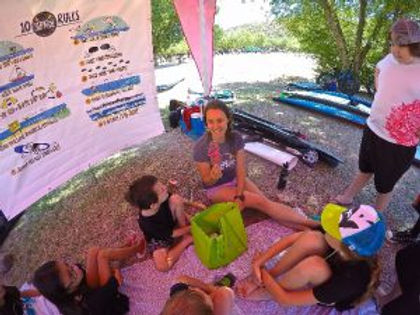Where most youth training programs focus on competition, SUP Kids has charted a different course. SUP Kids is a worldwide program which uses SUP as a platform for teaching kids ages 5-12 environmental education and water safety. It all began back in 2014 when Linzi Hawkin was approached to set up a SUP school in Far North Queensland on a three-month consultancy contract. At the time, Hawkin was living through an English winter and didn’t hesitate at the opportunity for adventure and more favorable weather.

Photo: Franz Orsi
The school was intended to serve an indigenous community and instruction was delivered in a lagoon due to the hazards in the nearby ocean. Hawkin found the new school was easy to set up and teaching in the lagoon was as snap as it was essentially a glorified swimming pool.
“Unlike teaching kids to surf, [where] you can teach a kid every day and still have plenty to teach them, you can teach kids stand up paddleboarding, especially in a pool, in about 15 minutes,” said Hawkin. “I quickly realized you need to have a little more up your sleeve to keep kids interested.”
Hawkin began to draw from her background in environmental education and water safety to develop a balanced curriculum which began to receive outside attention. Together with a husband and wife team, she partnered with the Royal Flying Doctor Service to go on tour and teach the SUP Kids program to additional indigenous communities. Given the hazards in the areas they planned to work in, e.g. crocodiles and stingrays, the program could only be run during the Australian winter.
Partnership with Starboard
Due to their work with the Royal Flying Doctor Service, SUP Kids received a fair amount of media attention. One day Hawkin received an email from Sven Rasmussen at Starboard inviting her to Thailand to meet the Starboard team and discuss their respective goals. It wasn’t long before it became clear their intentions were aligned. Hawkin then embarked on what was roughly a year of program development that culminated in a presentation to Starboard’s dealers. The presentation was well received and she then set out to scale the program so it could be easily replicated.
The initial plan called for Hawkin to deliver each training session, but as interest in the program spread they quickly realized that approach was not sustainable. Today the program is available online, and once accepted, virtually everything needed to set up a SUP Kids delivery center is provided.
“It is the type of program a lot of schools would love to do, but don’t have the resources to do on their own,” commented Hawkin. Just unpack and go!
The SUP Kids program

Photo: Jim Brewer
SUP Kids follows a standardized curriculum which may be delivered in one of three formats:
- Summer camp for five full days
- Once a week for five weeks
- Condensed one day version
Regardless of the format, the program covers five lessons:
- Safe SUP
- SUP adventures – getting kids outdoors
- Ocean plastics
- Healthy SUP Kid – yoga, nutrition, fitness
- Ambassador for the planet – Any kid that takes the program will leave with a goal of something they want to work towards in terms of a cause they care about.
In addition to their partnership with Starboard, SUP Kids has business relationships with Parley for the Oceans, Sustainable Surf, and Mafia Bags. The latter manufactures each SUP Kid’s backpack from recycled sails. SUP Kids is also partnered with the Thor Heyerdahl Climate Park in Myanmar where a mangrove tree is planted for each child that participates in SUP Kids.
SUP Kids is a registered B Corps and can be found in more than a dozen countries around the world. The program is so popular it essentially sells itself and Hawkin found there is little need to focus on marketing. Their partnership with Starboard has opened a lot of doors throughout the watersports industry. So much so that when asked, Hawkin said the biggest challenge is scaling the program to meet the demands of a global audience.
“If you are doing things in multiple territories in multiple languages, you have to keep things as simple as possible,” said Hawkin.

Photo: Jim Brewer
#Environment #Kids #YouthPrograms #SUPKids #Starboard #watersafety #LinziHawkins

